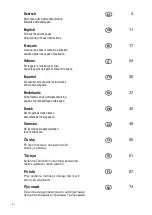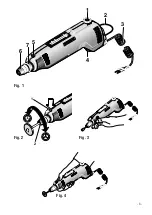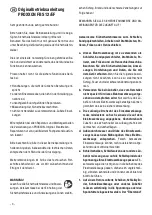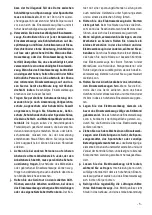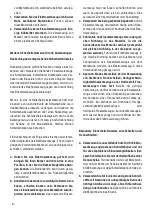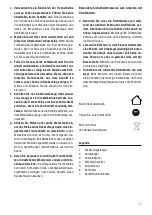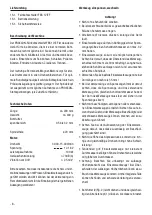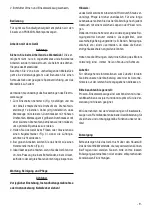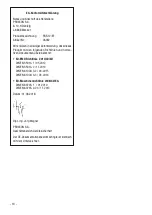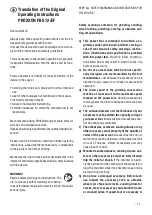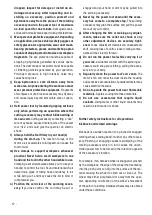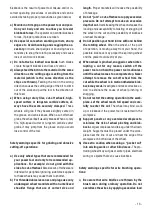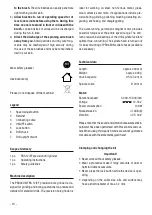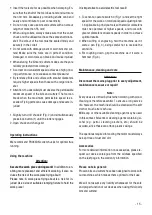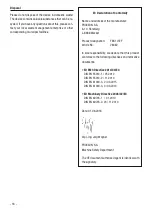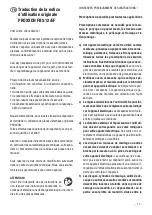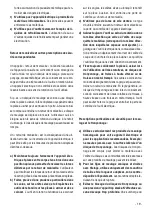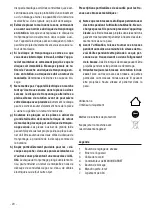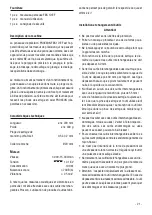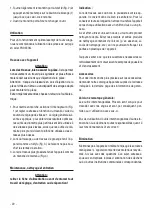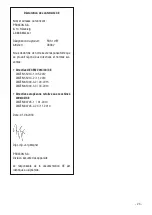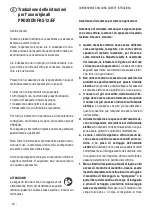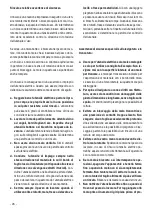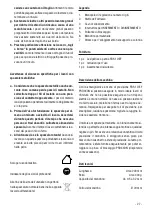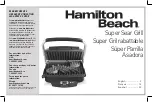
Kickback is the result of power tool misuse and/or in-
correct operating procedures or conditions and can be
avoided by taking proper precautions as given below.
a) Maintain a firm grip on the power tool and posi-
tion your body and arm to allow you to resist
kickback forces.
The operator can control kickback
forces, if proper precautions are taken.
b) Use special care when working corners, sharp
edges etc. Avoid bouncing and snagging the ac-
cessory.
Corners, sharp edges or bouncing have a
tendency to snag the rotating accessory and cause
loss of control or kickback.
c) Do not attach a toothed saw blade.
Such blades
create frequent kickback and loss of control.
d) Always feed the bit into the material in the same
direction as the cutting edge is exiting from the
material (which is the same direction as the
chips are thrown).
Feeding the tool in the wrong
direction causes the cutting edge of the bit to climb
out of the work and pull the tool in the direction of
this feed.
e) When using rotary files, cut-off wheels, high-
speed cutters or tungsten carbide cutters, al-
ways have the work securely clamped.
These
wheels will grab if they become slightly canted in
the groove, and can kickback. When a cut-off wheel
grabs, the wheel itself usually breaks. When a rotary
file, high-speed cutter or tungsten carbide cutter
grabs, it may jump from the groove and you could
lose control of the tool.
Safety warnings specific for grinding and abrasive
cutting-off operations:
a) Use only wheel types that are recommended for
your power tool and only for recommended ap-
plications. For example: do not grind with the
side of a cut-off wheel.
Abrasive cut-off wheels are
intended for peripheral grinding, side forces applied
to these wheels may cause them to shatter.
b) For threaded abrasive cones and plugs use only
undamaged wheel mandrels with an unrelieved
shoulder flange that are of correct size and
length.
Proper mandrels will reduce the possibility
of breakage.
c) Do not “jam” a cut-off wheel or apply excessive
pressure. Do not attempt to make an excessive
depth of cut.
Overstressing the wheel increases the
loading and susceptibility to twisting or snagging of
the wheel in the cut and the possibility of kickback
or wheel breakage.
d) Do not position your hand in line with and behind
the rotating wheel.
When the wheel, at the point
of operation, is moving away from your hand, the
possible kickback may propel the spinning wheel
and the power tool directly at you.
e) When wheel is pinched, snagged or when inter-
rupting a cut for any reason, switch off the
power tool and hold the power tool motionless
until the wheel comes to a complete stop. Never
attempt to remove the cut-off wheel from the
cut while the wheel is in motion otherwise kick-
back may occur.
Investigate and take corrective ac-
tion to eliminate the cause of wheel pinching or
snagging.
f) Do not restart the cutting operation in the work-
piece. Let the wheel reach full speed and care-
fully re-enter the cut.
The wheel may bind, walk
up or kickback if the power tool is restarted in the
workpiece.
g) Support panels or any oversized workpiece to
minimize the risk of wheel pinching and kick-
back.
Large workpieces tend to sag under their own
weight. Supports must be placed under the work-
piece near the line of cut and near the edge of the
workpiece on both sides of the wheel.
h) Use extra caution when making a “pocket cut”
into existing walls or other blind areas.
The pro-
truding wheel may cut gas or water pipes, electrical
wiring or objects that can cause kickback.
Safety warnings specific for wire brushing opera-
tions:
a)
Be aware that wire bristles are thrown by the
brush even during ordinary operation. Do not
overstress the wires by applying excessive load
- 13 -
Summary of Contents for FBS 12/EF
Page 81: ... 81 ...
Page 84: ... 84 ...


